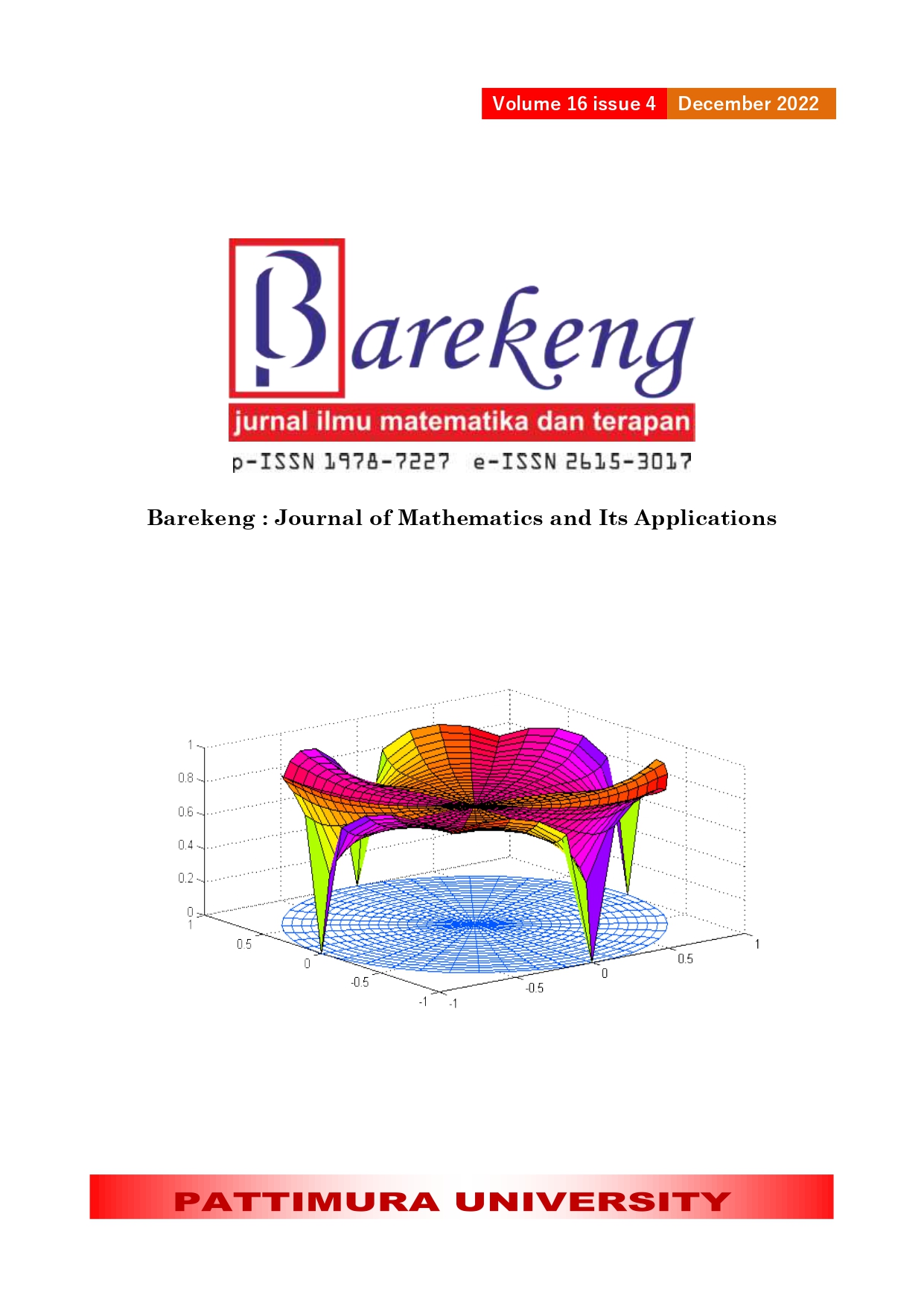MODELING OF BOND YIELD CURVE USING CUBIC BEZIER CURVE
Abstract
Investors attracted to Bond have to analyze the Bond yield curve. In this study, the bond yield curve is modeled using a cubic bezier curve. The cubic bezier curve is flexible, precise, and simple to use and evaluate. The bonds used in this study are Surat Berharga Negara (Government Paper) Fix Rate type dated August, 2nd–6th 2021. Bond data is obtained from the Indonesia Stock Exchange https://www.idx.co.id. The results show that the bond yield curve that is formed varies because bond yields change every time following market developments. The cubic bezier curve is able to model the bond yield curve well. Cubic bezier curves have 4 control values that help guide the curve well. The MSE value obtained by the bezier curve is small in general. The MSE values of the cubic bezier curve for the Bond yield data, sequentially from the least to the greatest, are 0,098 on August 4th, 2021; 0,1719 on August 5th, 2021; 0,2161 on August 3rd, 2021; 0,2498 on August 6th, 2021; and 0,2906 on August 2nd, 2021.
Downloads
References
J. Hännikäinen, “When does the yield curve contain predictive power? Evidence from a data-rich environment,” Int. J. Forecast., vol. 33, no. 4, pp. 1044–1064, Oct. 2017, doi: 10.1016/J.IJFORECAST.2017.05.006.
M. N. Ali et al., “Estimating the Yield Curve for the Malaysian Bond Market Using Parsimony Method,” Procedia Econ. Financ., vol. 31, no. 15, pp. 194–198, 2015, doi: 10.1016/s2212-5671(15)01220-4.
H. Kaya, “Forecasting the yield curve and the role of macroeconomic information in Turkey,” Econ. Model., vol. 33, pp. 1–7, Jul. 2013, doi: 10.1016/J.ECONMOD.2013.03.013.
A. Abdymomunov, “Predicting output using the entire yield curve,” J. Macroecon., vol. 37, pp. 333–344, Sep. 2013, doi: 10.1016/J.JMACRO.2013.05.002.
J. Levant and J. Ma, “A dynamic Nelson-Siegel yield curve model with Markov switching,” Econ. Model., vol. 67, pp. 73–87, Dec. 2017, doi: 10.1016/J.ECONMOD.2016.10.003.
M. Guidolin and M. Pedio, “Forecasting and trading monetary policy effects on the riskless yield curve with regime switching Nelson–Siegel models,” J. Econ. Dyn. Control, vol. 107, p. 103723, Oct. 2019, doi: 10.1016/J.JEDC.2019.103723.
F. Vieira, M. Fernandes, and F. Chague, “Forecasting the Brazilian yield curve using forward-looking variables,” Int. J. Forecast., vol. 33, no. 1, pp. 121–131, Jan. 2017, doi: 10.1016/J.IJFORECAST.2016.08.001.
W. Ullah and K. M. Bari, “The Term Structure of Government Bond Yields in an Emerging Market,” J. Econ. Forecast. Inst. Econ. Forecast., vol. 3, pp. 5–28, 2018.
C. Almeida, A. Simonsen, and J. Vicente, “Forecasting Bond Yields with Segmented Term Structure Models,” Work. Pap. Ser. 288, pp. 1–44, 2012.
P. Feng and J. Qian, “Forecasting the yield curve using a dynamic natural cubic spline model,” Econ. Lett., vol. 168, pp. 73–76, Jul. 2018, doi: 10.1016/J.ECONLET.2018.04.009.
C. Gerhart and E. Lütkebohmert, “Empirical analysis and forecasting of multiple yield curves,” Insur. Math. Econ., vol. 95, pp. 59–78, Nov. 2020, doi: 10.1016/J.INSMATHECO.2020.08.004.
O. Castello and M. Resta, “Modeling the Yield Curve of BRICS Countries: Parametric vs. Machine Learning Techniques,” Risks, vol. 10, no. 2, 2022, doi: https://doi.org/10.3390/risks10020036.
Z. Duraklı and V. Nabiyev, “A new approach based on Bezier curves to solve path planning problems for mobile robots,” J. Comput. Sci., vol. 58, p. 101540, Feb. 2022, doi: 10.1016/J.JOCS.2021.101540.
M. A. Fortes and E. Medina, “Fitting missing data by means of adaptive meshes of Bézier curves,” Math. Comput. Simul., vol. 191, pp. 33–48, Jan. 2022, doi: 10.1016/J.MATCOM.2021.07.025.
A. Okumura, “Optimization of the collection efficiency of a hexagonal light collector using quadratic and cubic Bézier curves,” Astropart. Phys., vol. 38, no. 1, pp. 18–24, 2012, doi: 10.1016/j.astropartphys.2012.08.008.
A. Rababah and M. Jaradat, “Approximating offset curves using Bezier curves ´ with high accuracy,” Int. J. Electr. Comput. Eng., vol. 10, no. 2, pp. 1648–1654, 2020.
M. Louzazni and S. Al-Dahidi, “Approximation of photovoltaic characteristics curves using Bézier Curve,” Renew. Energy, vol. 174, pp. 715–732, Aug. 2021, doi: 10.1016/J.RENENE.2021.04.103.
G. Hu, C. Bo, G. Wei, and X. Qin, “Shape-adjustable generalized Bézier surfaces: Construction and it is geometric continuity conditions,” Appl. Math. Comput., vol. 378, p. 125215, Aug. 2020, doi: 10.1016/J.AMC.2020.125215.
D. Brander, J. A. Bærentzen, A. S. Fisker, and J. Gravesen, “Bézier curves that are close to elastica,” Comput. Des., vol. 104, pp. 36–44, Nov. 2018, doi: 10.1016/J.CAD.2018.05.003.
L. Chen, D. Qin, X. Xu, Y. Cai, and J. Xie, “A path and velocity planning method for lane changing collision avoidance of intelligent vehicle based on cubic 3-D Bezier curve,” Adv. Eng. Softw., vol. 132, no. November 2018, pp. 65–73, 2019, doi: 10.1016/j.advengsoft.2019.03.007.
O. Coskun and H. S. Turkmen, “Multi-objective optimization of variable stiffness laminated plates modeled using Bézier curves,” Compos. Struct., vol. 279, p. 114814, Jan. 2022, doi: 10.1016/J.COMPSTRUCT.2021.114814.
G. Bai and W. Fang, “Application of Quasi-Cubic Bézier Curves in the Blending of Tubes with Different Radiuses,” IOP Conf. Ser. Mater. Sci. Eng., vol. 612, no. 3, 2019, doi: 10.1088/1757-899X/612/3/032171.
A. Álvarez-Trejo, E. Cuan-Urquizo, A. Roman-Flores, L. G. Trapaga-Martinez, and J. M. Alvarado-Orozco, “Bézier-based metamaterials: Synthesis, mechanics and additive manufacturing,” Mater. Des., vol. 199, p. 109412, Feb. 2021, doi: 10.1016/J.MATDES.2020.109412.
Copyright (c) 2022 Emy Siswanah

This work is licensed under a Creative Commons Attribution-ShareAlike 4.0 International License.
Authors who publish with this Journal agree to the following terms:
- Author retain copyright and grant the journal right of first publication with the work simultaneously licensed under a creative commons attribution license that allow others to share the work within an acknowledgement of the work’s authorship and initial publication of this journal.
- Authors are able to enter into separate, additional contractual arrangement for the non-exclusive distribution of the journal’s published version of the work (e.g. acknowledgement of its initial publication in this journal).
- Authors are permitted and encouraged to post their work online (e.g. in institutional repositories or on their websites) prior to and during the submission process, as it can lead to productive exchanges, as well as earlier and greater citation of published works.






1.gif)



